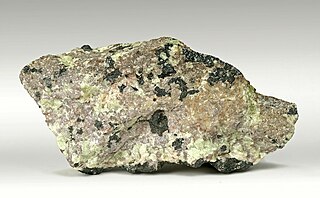Glaucocroíta
| Glaucocroíta | ||
|---|---|---|
 | ||
| General | ||
| Categoría | Minerales nesosilicatos | |
| Clase | 9.AC.05 (Strunz) | |
| Fórmula química | CaMn2+SiO4 | |
| Propiedades físicas | ||
| Color | verde azulado, o micro cristales rosáceos, o marrón si masivo | |
| Raya | blanca | |
| Lustre | vítreo, resinoso | |
| Transparencia | opaco a semitrnsparente | |
| Sistema cristalino | Ortorrómbico dipiramidal | |
| Hábito cristalino | Cristales largos prismáticos y sin terminación, agregados, también masivo de grano fino | |
| Macla | de penetración o de contacto | |
| Exfoliación | muy pobre en {001} | |
| Fractura | concoidea | |
| Dureza | 6 (Mohs) | |
| Tenacidad | frágil | |
| Densidad | 3.407 g/cm³ | |
| Propiedades ópticas | biaxial, con dispersión marcada | |
La glaucocroíta es un mineral de la clase de los nesosilicatos, y dentro de esta pertenece al llamado “grupo del olivino”. Fue descubierta en minas de Franklin,[1] en Nueva Jersey (Estados Unidos), nombrado en 1899 por S. L. Penfield y C. H. Warren del griego γλαυκός (verde-azul) y χρώσις (coloración), en alusión a su color.[2] Un sinónimo poco usado es calcotefroíta.
Características químicas
[editar]Es un silicato anhidro de calcio y manganeso, del tipo nesosilicato,[3] que cristaliza en el sistema cristalino ortorrómbico,[4] isoestructural con la fayalita y la forsterita.[5] Además de los elementos de su fórmula, suele llevar como impurezas: hierro, zinc, plomo y magnesio.
Formación y yacimientos
[editar]Se ha encontrado como material masivo en yacimientos de minerales del zinc en estratos metamorfizados en Franklin (Nueva Jersey),[3] en skarn en la zona de contacto entre diabasa y mármol en Siberia (Rusia),[6] en depósitos de minerales del manganeso en rocas silicatos-cálcicos en Sudáfrica y Namibia.
Suele encontrarse asociado a otros minerales como: nasonita, willemita, andradita, hardystonita, tefroíta, clinoedrita, esperita, leucofenicita, hodgkinsonita, diópsido, cuspidina, calcita, franklinita o cincita.
Referencias
[editar]- ↑ Palache, C. (1935). «The minerals of Franklin and Sterling Hill, Sussex County, New Jersey». U.S. Geol. Sur. Prof. Paper (en inglés) 180: 79-80.
- ↑ Dana, E.S. (1899). «Glaucochroite». Dana's system of mineralogy. app. II. p. 46.
- ↑ a b Leavens, P.B.; Dunn, P.J. & Burt, D.M. (1987). «Glaucochroite (olivine, CaMnSiO4) from Franklin, New Jersey: its composition, occurrence, and formation». Amer. Mineral. (en inglés) (72): 423-428.
- ↑ O'Mara, J.H. (1951). «Unit cell and space group of glaucochroite». Amer. Mineral. (en inglés) (36): 918.
- ↑ Lager, G.A. & Meagher, E.P. (1978). «High-temperature structural study of six olivines». Amer. Mineral. (en inglés) (63): 365-377.
- ↑ Pertsev, N.N. & Laputina, I.P. (1974). «Glaucochroite in the Anakit skarns, Lower Tunguska». Doklady Acad. Nauk SSSR (en ruso) (216): 1379-1382.
- Glaucocroíta, en mindat.org.
- Glaucocroíta, en webmineral.com.
- Manual de glaucocroíta, Mineral Data Publishing.
Enlaces externos
[editar] Wikimedia Commons alberga una categoría multimedia sobre Glaucocroíta.
Wikimedia Commons alberga una categoría multimedia sobre Glaucocroíta.
Text is available under the CC BY-SA 4.0 license; additional terms may apply.
Images, videos and audio are available under their respective licenses.
